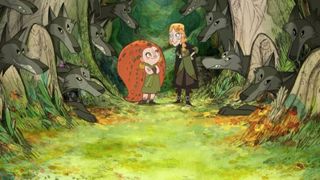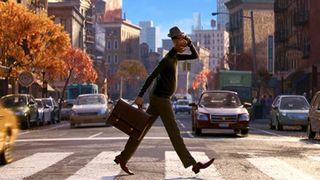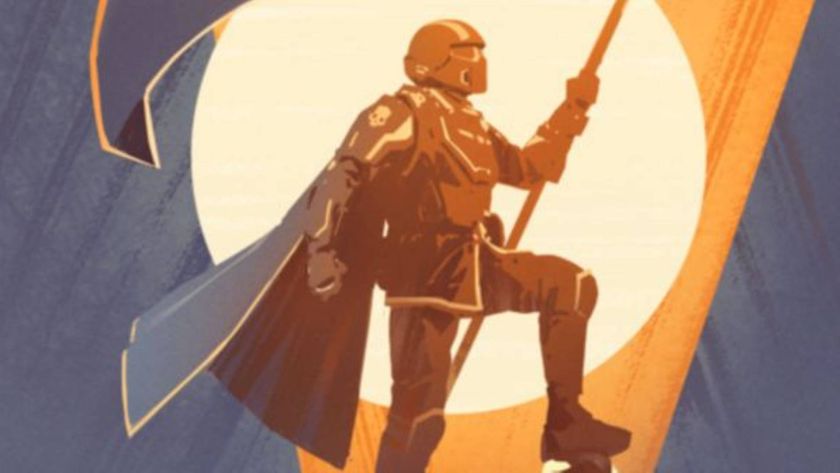The 25 best movies of 2020
From time-inverting blockbusters to intimate indies, these are the 25 best movies of 2020

It's been quite a year. Yet, despite cinemas being closed around the world, 2020 has been another stellar twelve months for film. Thanks to streaming and on-demand services, some of the best movies of 2020 didn't play on the big screen, but on our televisions. That hasn't done anything to dim the quality of these brilliant flicks – and choosing this list was, as it is every year, a struggle.
There were tears, there were tantrums, but Total Film’s scribes finally agreed on the best movies of 2020. The bad news? Hubie Halloween didn’t make it. The good news? Uncut Gems did. And the competition was fierce... To note: due to our staff being UK-based, we have chosen movies released between January 1 and December 31 in the UK. That means no Nomadland, but Parasite counts.
25. Shirley

American author Shirley Jackson is best known for conjuring The Haunting Of Hill House. But the creation of her 1951 bildungsroman Hangsaman is the focus of Josephine Decker’s experimental ‘biopic’, which reframes a period in Jackson’s life as though it were one of her famously unsettling tales.
As a work of fiction, it’s an engrossing and twisted tale that plays on the tropes of Jackson’s own stories (creepy homes, the occult, unhappy marriages) rather ingeniously. At times it can feel like an adaptation of a lost Jackson short story, Decker casting a spell with bewitching, shallow-focus camerawork.
24. Song Without A Name

Melina León’s account of Georgina (Pamela Mendoza), a young, destitute mother in civil war-stricken Peru, who has her child stolen after giving birth at a fake clinic, shows the plight of those with nothing trying to take on a world that barely acknowledges their existence.
A journalist (Tommy Párraga) discovers her case and starts unveiling the horrific, real-life-inspired truth. Aptly captured in timeless 4:3 monochrome, this is a work of singular delicacy, starkly beautiful in its desolation and profoundly sad.
23. Harley Quinn: Birds of Prey

Having largely binned off the extended-universe gambit, DC Comics has found its groove, and Birds Of Prey proves that DC is at its best when it cuts loose. While this picks up with Harley Quinn after 2016’s Suicide Squad, you wouldn’t exactly call it a sequel; it’s tonally very different and doesn’t carry over any characters besides Harley. In fact, it most resembles Deadpool, with its R-rated antihero, fourth-wall demolishing, and irreverent tone that takes its cues from the title character.
Sign up for the Total Film Newsletter
Bringing all the latest movie news, features, and reviews to your inbox
With a pace that rattles along like a roller derby, a successful gag rate, and general tone of irreverence – a filthily delicious-looking sandwich is integral to Harley’s plot arc – it’s relentless, hyperactive, and viciously entertaining. Just like Harley herself.
22. Bombshell

The first major #MeToo movie, Bombshell tracks the struggle to end Fox News supremo Roger Ailes’ 20-year reign as a sexual predator. A pacy, glossy, star-packed drama about the high cost of doing the right thing, it swerves the preachy, women-as-victims lecture mode. Instead, it dunks you head-first into Manhattan’s crazily cut-throat and uber-Republican Fox News fortress, the most-watched cable network in America. Charlize Theron’s uncanny, authoritative Megyn Kelly (Fox’s famous queen bee) whisks us on a playful, Vice-style, audience-addressing tour of Ailes’ kingdom,
Bombshell’s blondes are engagingly flawed – morally compromised, professionally ruthless, full of divided loyalties. Roach and Randolph’s biggest achievement here is in getting under their skin, to show how sexual harassment creates a workplace that crackles with danger and uncertainty for women. Like their Network (1976) predecessor, they’re mad as hell, and they’re not going to take it any more.
21. 1917

Though not a true ‘oner’, 1917’s dazzlingly long takes were among the most impressive technical feats of 2020 in film. Bagging The Deaks his second Oscar, the breath-snatching cinematography was anything but a gimmick, fully immersing viewers as George MacKay’s squaddie trudges through muddy trenches and dodges relentless rifle fire.
Co-scripted by director Sam Mendes, and with a story inspired by his grandfather’s experiences in World War One, it was a passion project that – like Christopher Nolan’s Dunkirk before it – breathed new life into a well-worn genre.
20. The Vast Of Night

Few genres suit large and small movies like science-fiction. Andrew Patterson’s debut cost under a million dollars but acted as a mighty big calling card as he melded teen drama and sci-fi paranoia while paying homage to the golden age of radio and the coming of TV.
Set in small-town New Mexico in the 1950s, as a radio DJ (Jake Horowitz) and switchboard operator (Sierra McCormick) discover a strange audio frequency, it maintained a mastery of mood throughout and offered up one of the most startling tracking shots of the year.
19. Never Rarely Sometimes Always

Eliza Hittman’s clear-eyed drama about a teen girl (talented newcomer Sidney Flanigan) seeking an out-of-state abortion was certainly an ‘issues movie’ in a year when female healthcare was under serious threat. But the delicacy with which Hittman unpicked casual misogyny, the sisterhood of friends and rural socio-economics ensured an urgent feminist story. And that gut-punch scene that gave the film its title was achieved in one take.
“I try and avoid making more message-driven work,” said Hittman, “but this film is really about the impact that those barriers [to getting a termination] have on people’s lives.”
18. Rocks

“Recalls The Bicycle Thief redone in rich colours with a hip Afrobeat soundtrack,” wrote Variety. High praise indeed for Sarah Gavron’s London-set realist drama, which likewise turned to non-professional actors to tell the tale of teenager Shola (Bukky Bakray), left to care for herself and her younger brother (D’angelou Osei Kissiedu) when their mum does a runner.
Workshopped for a year, Rocks felt alive and authentic, refusing to hit viewers over the head with the kitchen sink, but rubbing plenty of grit into its celebration of female friendship.
17. Possessor

Brandon Cronenberg proved he’s well on his way to becoming his celebrated father’s equal with a sci-fi body horror so disturbing it made Crash look like Cars. The film stars Andrea Riseborough as a ghost-in-the-shell assassin who hijacks minds to pull off the perfect kill, and Cronenberg’s accomplished world-building and smart exploration of meaty themes (identity, the connection between body and mind) was impressively matched by Dan Martin’s sickeningly icky special effects.
“The film doesn’t turn away,” said Cronenberg of Possessor’s unflinching depiction of visceral violence. You’ll be riveted, too.
16. Relic

Ostensibly a tale of the supernatural about a woman (Emily Mortimer) trying to solve her OAP mother’s disappearance and the literal bumps in the night within Ma’s creaky ancestral home, this imaginatively unsettling debut by Japanese-Australian writer/director Natalie Erika James was really a treatise on ageing, dementia, grief and the burden of care on women.
“There’s something really comforting about sharing it with people and realising other people have been through similar things,” said Mortimer, whose late father struggled with dementia. “It makes us human.”
15. Wolfwalkers

Wolves, magic, medieval combat, Sean Bean... it would be tempting to call Cartoon Saloon’s high- class hairy-tale ‘Game Of Thrones for kids’, were it not one of those rare animated features that also makes adults cry “Again! Again!” Behind the narrative simplicity – wolves vs. woodcutters – lay emotional sophistication and wild artistic ambition: expressionistic flourishes, contrasting styles (woodcut, watercolour) and the best use of swirly smell trails this side of a Bisto advert.
It also seamlessly wove the mythical (forest shapeshifters) with the factual (antagonist Oliver Cromwell). “It’s fun to play with history,” said co-director Ross Stewart.
14. Wonder Woman 1984

Wonder Woman 1984 is just the blockbuster 2020 needed. Like Joker, it plugs into all of the loneliness and disappointment and fear and rage that so many have harboured these last few years, but gives it all a positive spin to deliver a message of love and hope and connection across all borders. There’s a purity to Jenkins’ picture that might have felt naïve five years ago, but now feels not only most welcome but necessary.
This sequel lassos the truth of the here and now even as people in shell suits walk past gigantic music stores. It’s time to flip the record, it’s saying – time for sacrifice and kindness. Now that’s music for the heart.
13. I'm Thinking Of Ending Things

“I’ve made a practice throughout my career of not explaining my intent,” said Charlie Kaufman in July when publicising his first novel, Antkind. Better, he leaves it to others to theorise – and boy, did everyone and their shaking dog have a hot take on his Netflix movie I’m Thinking Of Ending Things, in which time and truth come undone when an awkwardly dating couple (Jessie Buckley, Jesse Plemons) go to visit his folks (Toni Collette, David Thewlis).
A head-scratching odyssey, it was beautiful and horrific, hopeful and bleak. Buckley and Plemons are excellent as the central duo.
12. Host

Welcome to the new paranormal: a movie that used video-conferencing app Zoom to re-energise the found-footage genre, as six (if you count Teddy) friends get together in lockdown for a virtual séance that goes violently awry. “I wanted to subvert people’s expectations,” said director Rob Savage. “Because I think it sounds like a shit idea on paper.”
On Shudder, though, it became a phenomenon, drawing gasps of admiration at its resourcefulness (everyone coming together to work remotely) and screams of terror at its scare tactics, which range from topical isolation exploitation to good old- fashioned Boo! (and fake Boo!) moments. App fab.
11. Calm With Horses

A scorching debut from National Film and Television School grad Nick Rowland, this followed the misfortunes of boxer-turned-heavy Arm (Cosmo Jarvis) in rural Ireland as he struggled to balance fatherhood to an autistic child, servitude to a ruthless gangster and some kind of humanity amid the carnage. With a thrumming Blanck Mass soundtrack amplifying the tension, Calm With Horses was loved by festivals and scuppered by lockdown.
“Two days into release, all the cinemas closed down,” said Rowland. “It’s heartbreaking, but you have to put things into perspective; at least the film exists.” It’s now on Netflix in the UK.
10. The Assistant

“It’s a film about monotony,” said writer/director Kitty Green. “But I didn’t want it to be too monotonous.” On the contrary, this #MeToo-era study of daily drudgery, misery and misogyny was never less than grimly gripping.
Some of its themes chimed with Bombshell, but Green’s film scored bigger dramatic impact on a much smaller scale, focusing on Julia Garner’s brilliantly understated performance as Jane, office assistant to a never-seen movie mogul. While the Weinstein parallels were inescapable, the movie’s true, devastating power lay in its acute evocation of every-office complacency, complicity and male entitlement.
9. Saint Maud

Rose Glass’ audacious debut burrowed deep into the mind of the evangelical nurse of the title (Morfydd Clark), whose religious fervour peaks when she tries to ‘save’ her patient (Jennifer Ehle). Evocatively filmed in Scarborough and offering multiple reads (is Maud mentally ill or anointed?), this gothic horror challenged audiences and ensured they never wanted to see a thumb tack again.
Just don’t call it ‘elevated’, a snobby term according to Glass. Her own description? “A fucked-up, hopefully fun character study which veers into horror. That’s always how I’ve thought about it.”
8. The Invisible Man

Horror remakes tend to come in two flavours: a dreadful waste of time (*cough* The Mummy), or a terrifyingly smart new spin. Leigh Whannell’s ground-up reimagining of James Whale’s horror classic fit squarely into the latter category. Deploying invisibility as a ferociously effective metaphor for gaslighting and psychological torture, it reimagined H.G. Wells’ titular transparent fella as a bogeyman rooted in real trauma, though Elisabeth Moss’ Cecilia was far from a hapless victim, resourceful and resilient to the film’s punch-the-air final frames.
Serious-minded it may be, but The Invisible Man didn’t skimp on rollercoaster scares, Whannell’s confident and creative set-piece shocks bolstered by smart, subtle VFX. “I wanted to make something that was like a boot on the throat of the audience,” said Whannell, whose work won him a shot at another horror icon with The Wolfman, which is set to star Ryan Gosling. If you’re anything like us, you’ll still be struggling to breathe.
7. Portrait Of A Lady On Fire

Released at the tail end of February, writer/director Céline Sciamma’s sensual, intellectual period romance thankfully made it to the big screen before UK cinemas were shuttered; this intimate tale deserved an epic canvas. It was also a film to be seen without threat of distraction, demanding – and amply rewarding – patience as it lit the spark of connection between 18th Century French painter Marianne (Noémie Merlant) and her latest subject, the portrait-shy Héloïse (Adèle Haenel).
“I really wanted to depart from this idea of love at first sight,” said Sciamma, who chose instead to linger on “the rise of desire, how it is built, how it is born”. The watchful Merlant and initially guarded Haenel delivered the necessary nuance, while DoP Claire Mathon crafted gallery-worthy images that reached a sublime peak with the celebrated bonfire scene. Save some applause, too for real-life artist Hélène Delmaire, whose talented hands stood in for Merlant’s during the film’s hypnotic painting sessions.
6. The Lighthouse

It wasn’t just the eponymous, incandescent structure that shone in Robert Eggers’ sophomore feature – Willem Dafoe and Robert Pattinson were career-best as wild-eyed wickies Tom Wake and Ephraim Winslow, who lose the plot when they’re stranded on a wind-lashed island off the coast of New England. Shot in black-and-white using lenses manufactured in the 1930s, and in the archaic 1.19:1 aspect ratio, Eggers’ nightmarish vision felt anything but old hat.
After years of credible indie character work, Pattinson put the final nail in Edward Cullen’s coffin while wrestling with vindictive seagulls and mermaid vaginas. As for Dafoe, no other actor could so convincingly spit pages of dialogue penned in authentic 19th Century Maine dialect. “Nothing good happens when two men are trapped in a giant phallus,” quipped Eggers. We beg to differ – The Lighthouse was peerless filmmaking from a director emerging as one of contemporary horror’s true trailblazers.
5. Soul

When Pixar’s 23rd feature made its bow at the London Film Festival in October, reviewers all agreed the animation giant was on its A-game. As New York jazz musician Joe (Jamie Foxx) was transported out of his body, Soul floated us away to The Great Before, where infant souls are readied to inhabit hosts on Earth... and where Joe must mentor the precocious 22 (Tina Fey).
Moving between a photorealistic New York and the softer, more abstract The Great Before, Soul offered up stunning animation and a heart-swelling message about grabbing life where you can. We need this story right now, and Pixar gifted it to us for Christmas – it lands on Disney Plus on 25 December, available to subscribers for no extra charge. “The themes are heightened right now,” said producer Dana Murray. “We all agreed that we had to get the film out there.”
4. Mank

This time it was personal... Written by his late father Jack, David Fincher’s Mank also reverberated with all of the knowledge the filmmaker had accumulated from his 30 years in Hollywood, ever since, aged 27, he stood on the set of Alien3 armed with ambition, ego and talent... much like a 24-year- old Orson Welles gatecrashed Hollywood decades before him. In Mank, alcoholic screenwriter Herman J. Mankiewicz (Gary Oldman giving his best for 30 years) pens Welles’ directorial debut Citizen Kane from a ranch in Victorville, California, in 1940, while Kane-like flashbacks show us just how he arrived at his most important work.
Shot in black-and-white with a mono soundtrack to resemble a lost classic of the era, Mank matched its technical brilliance with a witty, perspicacious script dealing with ambition, self-doubt, authorship, politics, and the power of the word. “It’s a story about a brilliant wordsmith who finally understands the value and importance of his voice,” said Fincher.
3. Uncut Gems

The title said it all, as New York’s Safdie brothers (Good Time) dug out a dirty, jagged indie that sparkled from every angle. Their dad, a salesman in Manhattan’s diamond district, was the inspiration for Adam Sandler’s motor-mouthed jeweller Howard Ratner, drowning in gambling debt but spying a way out when he lands a large Ethiopian gem. “Dad’s stories were always such pulpy, mini-epic thrillers,” said Josh, older sibling of Benny.
Well, Uncut Gems was exactly that, never pausing for breath as the suffocating tension built and built and built, with Howard juggling family, a mistress, circling lowlifes, NBA star Kevin Garnett and that whopping jewel. At two-and-a-quarter hours long, with enough overlapping dialogue to fill a movie three times that length, the film was intimately shot with handheld cameras, while brisk, choppy editing sucked out any last pockets of air. The result was a thriller that pummelled and punished viewers... and was all the more exhilarating for it.
2. Parasite

Bong Joon-ho’s genre-mashing masterpiece this year added Best Picture and Best Director Oscars to go with 2019’s Palme d’Or, and took a whopping $258m at the worldwide box office. It’s not hard to see why: Bong seamlessly blended audience thrills with social commentary to fashion a rare film that would play to repertory cinemas and multiplexes alike, as the miserably poor Kim family strategised like chess masters to infiltrate the home of the wealthy Parks, only for a jaw-plummeting midway twist to toss all of the pieces on the board up in the air and watch them rattle across the floor in supremely orchestrated chaos.
Bong himself worked as a tutor while in college, and said he felt like he was “spying on this rich family”. The idea then grew inside him for decades, “like a parasite.” And what a slippery film it proved to be, twisting and turning to make viewers spasm in shock.
1. Tenet

You have to admire Christopher Nolan’s mettle. Not only did he and Warner Bros commit to releasing his $200 million-plus blockbuster theatrically when such heroes as James Bond, Wonder Woman and Maverick were all cowering behind the sofa, but he also hit us with his biggest mind-scrambler since Memento: a sci-spy actioner with physics and philosophy to go with its sexy suits and kamikaze car chases.
On one level, it was standard stuff, as a CIA agent we know only as the Protagonist (John David Washington) joined another, even- more-top-secret espionage outfit to trot the globe (India, Oslo, Italy, Russia) in an effort to stave off a terrorist threat, or perhaps even save the world. The Protagonist’s gallivanting brought him into contact with a British intelligence officer (Robert Pattinson), an Indian arms dealer (Dimple Kapadia), and a dastardly Anglo-Russian oligarch (Kenneth Branagh) with a sad, beautiful, but oh-so- capable wife (Elizabeth Debicki)... But such genre tropes acted as much-needed handrails given the world (-building) in Tenet was to spin so far off its axis it made that tilting-corridor scrap in Inception seem like a stroll in the park.
As everyone knows by now, Tenet’s trump card was its concept of ‘time inversion’, whereby objects can be sent from the future back to the present. For those wanting to understand what, exactly, that meant, there was a plethora of Time Inversion For Idiots guides published after the film’s release, meaning we could all start dropping phrases like “reverse entropy” and “effect followed by cause” like we knew what we were talking about. Scientists were co-opted by movie sites to assure us that it did all actually make sense, kind of, and Nolan himself said, “For ambiguity to resonate, the audience has to feel there is an underlying truth.”
Some viewers couldn’t wrap their heads around it – Tenet was more divisive than Nolan’s Dark Knight Trilogy, for sure. But follow the advice of Clémence Poésy’s scientist (“Don’t try to understand it. Feel it”) and what you had was an avant-garde, metaphysical, super-suspenseful blockbuster that surged forward with ruthless momentum even as cars, bullets and a 747 slid past in the opposite direction in a barrage of temporal- twiddling set-pieces lit up by explosions and implosions.
“Bold I’m fine with, I was afraid you were going to say nuts,” said a character played by Himesh Patel who aids the Protagonist and Neil in crashing a plane into an Oslo airport. Well, Tenet is bold and nuts, and the best movie of 2020.
Need more watching recommendations? Then check out the best Netflix movies and best movies on Amazon Prime to watch right now.

Jack Shepherd is the former Senior Entertainment Editor of GamesRadar. Jack used to work at The Independent as a general culture writer before specializing in TV and film for the likes of GR+, Total Film, SFX, and others. You can now find Jack working as a freelance journalist and editor.











